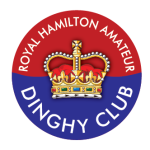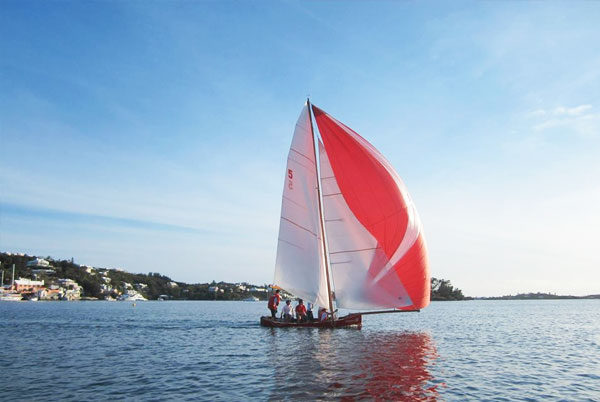History
[one_half]
The Hamilton “Dingey” Association became an entity as a result of Fitted “Dingey” Races held by a Hamilton School (Head Master Charles E. Clay) in 1882. The Club was formed with Joseph Trimingham being the first Commodore. It is believed the first meetings were held in his house.
The Club, in its new premises, introduced “amateur” fitted dinghy racing and was later recognized as a gentlemen’s luncheon club to include sailing, tennis, snooker and social events all rolled into one.
In 1883 H.R.H. Princess Louise, Marchioness of Lorne, and Wife of Canada’s Governor General, conferred the title “Royal” to the Club, whilst on a winter holiday. On becoming the ROYAL HAMILTON AMATEUR “DINGEY” CLUB, a white Flag, traditional style of the British Yacht Clubs of the time, was uniquely designed for the Club’s exclusive use.
William Whitney donated twenty pounds to purchase a Challenge Cup for the Club.
A silver Cup was presented to the Club by H.R.H. Princess Louise in 1887. This was to be raced to celebrate Queen Victoria’s Jubilee, hence the Jubilee Cup.
In 1890 the procedure governing titles was changed and the privilege was given to reigning Monarchs only. Hence the Royal title was lost. The Membership decided to extend itself into a social Club and find a Clubhouse. In March 1890 rooms were taken over on the second floor of the house on the corner of Reid and Queen streets.
In 1896 the word Amateur was dropped and the name of Hamilton Dinghy Club held until 1953. Also, the red ensign of the Merchant service with foul gold anchor and letters HDC under the anchor, was adopted along with a corresponding Burgee.
25th September, 1899 saw a move to “Belvoir” J.E.Lightbourn’s house on Reid Street, to become “the Most Commodious Clubhouse in town”. A fire in 1916 destroyed many records.
The Championship (Jubilee) Cup Regatta was held for first time 1912.
1927 the Club purchased an imposing mansion on Church Street, Hamilton. This was opposite the site of the old Hamiltonian Hotel. Called an “Oasis in the City”, it had a front lawn with two Royal Poinciana trees. The Club became incorporated at that time.
The 1930’s were hard times. Rear property was sold and actions of staunch members saved the day.
In 1944 the Championship Cup competition was revived, thereby expanding the sport of Fitted Dinghy racing of old dinghies.
The position was investigated in 1946, and it was decided to apply to H.M. Queen Elizabeth II for her confirmation of the grant by H.R.H. Princess Louise in 1883. Confirmation was received in 1953. On Thursday, 4th June, 1953 at a ceremony at the Club premises in Hamilton, His Excellency the Governor, Lt. Gen. Sir Alexander Hood, G.B.E., (C.B.E.), K.C.B., (C.B.), K.C.V.O., officiated at the flag breaking ceremony, making this the only “Royal” dinghy club in the world.
The original flag, which is still in the Club premises, was traced to Messrs. Lanff & Neeve, 97 Leadenhall Street, London. They were bombed out during the 1939-1945 war and are now out of business. The original flag was recovered by Mr. Arthur Pitt and returned to the Club and presented by Mr. Edmund Gray to the then Commodore, the late William Frith. The new flag has been made in all respects similar to the original.
The 1927 Act altered by No. 7 of 1954 when the name was changed back from The Hamilton Dinghy Club to “The Royal Hamilton Amateur Dinghy Club”.
From its origin on Reid Street, the Club moved to Church Street, and in 1964 acquired its present premises overlooking Hamilton Harbour.
In 1977, the Club became co-sponsors of a cruising race held on a biennial basis between Marion, Massachusetts and Bermuda. The arrangements between the Beverly Yacht Club, the Blue Water Sailing Club and the RHADC has proved to be a resounding success, the attraction of a cruising and family race encouraging a large number of enthusiastic participants.
In 1990 the Club carried out a major refurbishment and remodeling to its premises so continuing its status as Bermuda’s premier maritime club.
Junior and Adult Sailing now offers year round courses with a record number of Optimist sailors qualifying and competing in the IODA International Regattas.
[/one_half][one_half_last]
Elizabeth II – The Fitted Dinghy
Click here for more information on Elizabeth II.
Timeline
-
1882
Hamilton Amateur Dingey Association (soon changed to “Club”) formed to organize fitted open dinghy races among its members, and by the end of that summer had held two race afternoons and a general regatta. -
1883
H.R.H. Princess Louise, Marchioness of Lorne and the wife of Canada’s Governor General extended her patronage to the Club, following a winter holiday in Bermuda during which she stayed at “Inglewood”, Paget, the home of J. L. Trimingham, the Commodore. On becoming the “Royal Hamilton Amateur Dingey Club”, a white Club flag was adopted in the traditional style of the British Royal yacht clubs of the time. -
1887
Amateur dinghy racing developed rapidly and to commemorate H.M. Queen Victoria’s Golden Jubilee, the R.H.A.D.C. and the St. George’s Amateur Boating Club established the Championship Cup to be competed for at the end of each racing season in a match race between the top boat of each club. This cup is generally known as the “Jubilee Cup”. -
1890
The procedure for granting Royal patronage was revised so that it became the exclusive right of the reigning monarch and, for reasons that are not clear, the Club lost its “Royal” title. Concurrently, the membership decided to expand into a social club and start a clubhouse. In March, the premises of the Hamilton Reading and Recreation Rooms on the second floor of the house at the corner of Reid and Queen Streets in Hamilton were taken over as the Club rooms. -
1894
Permanently decked dinghies were adopted as a second class of racing boats by the Club. -
1896
By unanimous agreement, “Amateur” was dropped from the Club name and for the next half century, it was known as the “Hamilton Dinghy Club”. At the same time, it was agreed that the Club flag “shall be a red ensign of the Merchant service with foul gold anchor with the letters H .D . C. under the anchor”. A corresponding red burgee was adopted. Only the burgee appears to have been flown. -
1899
After searching for a larger club premises for over two years, “Belvoir”, J. E. Lightbourn’s house on Reid Street (now occupied by Medical Hall) became “the most commodious Clubhouse in town” on 25 September. -
1916
A serious fire occurred in the Club premises and many of the records were destroyed, although fortunately the original R.H.A.D.C. minute book and several other turn of the century minute books survived. -
1920
Championship (Jubilee) Cup regatta held for the first time since 1912. -
1927
The Club purchased a building on Church Street, directly opposite the Hamilton Hotel on the site of the present Cable & Wireless Ltd. building for its new clubhouse; and at the same time, became Incorporated. -
1944
Competition for the Championship (Jubilee) Cup was revived after a seventeen year lapse, and the Club became very active in expanding the sport of fitted dinghy racing. Some of the old dinghies were recovered and restored, with the result that there has been a full season of dinghy racing every year since. -
1955
In January, it was announced that H.M. Queen Elizabeth II would be visiting Bermuda in November and it was decided to seek her approval to reestablish the Royal club name. A request addressed to H.E. the Governor on 10 February resulted in a reply from the Colonial Secretary’s office dated 8 April stating “that Her Majesty the Queen has been pleased to confirm the use of the title ‘Royal Hamilton Amateur Dinghy Club’ by your Club”. Three weeks later, the Colonial Secretary’s office authorized the flying of the original Club flag from the Club premises. Lieut. Gen. Sir Alexander Hood, GBE, KCB, the Governor, raised the flag at a special ceremony on 4 June to mark the resumption of the Club’s Royal Warrant and to celebrate the Coronation of H.M. Queen Elizabeth II (2 June). On 24 November, our Royal guest book was signed by both Her Majesty and H.R.H. the Duke of Edinburgh, when they witnessed a Fitted Dinghy Race sponsored by the Associated Clubs. The Club’s new dinghy “Elizabeth” was entered. -
1954
Presentation of the Sir Alexander Hood Cup by H.E. the Governor for annual competition between the R.H.A.D.C. and the R.B.Y.C. in a series of International One Design team races. After a few years, insufficient I.O.D. ‘s resulted in the series being abandoned and, although provision was made in the title deed for other boats to be substituted in this event, none was. -
1964
“Mangroville” on Pomander Road, Paget was purchased and the Club moved to its present premises; the Church Street property being sold. -
1974
The defaced red ensign showing a fitted dinghy on the fly was adopted to permit members with suitable boats and holding a warrant to show a Club ensign on the water. This ensign was also flown on the Club premises. -
1980
After due consideration, it was decided to fly the original white Club flag in front of the Club, with the defaced red ensign being used on members’ boats. This flag was hoisted by John Blee, the Commodore in 1953 who was responsible for the return of the Royal Warrant, on Christmas Eve. -
1982
Celebration of the Club’s centennial with a fortnight of activities in August, beginning with a special Fitted Dinghy Race in Hamilton Harbour and ending with a formal banquet. The original 1882 H.A.D.A. Cup was used as the Centennial Race trophy.
[/one_half_last]

